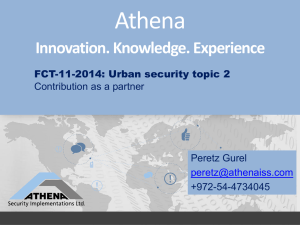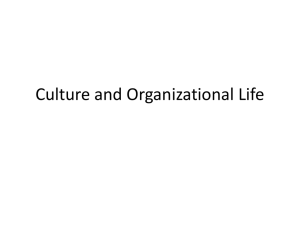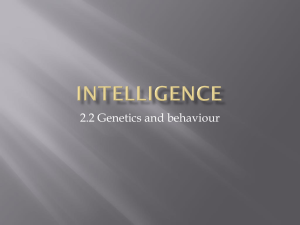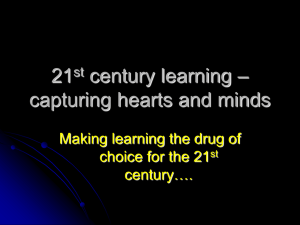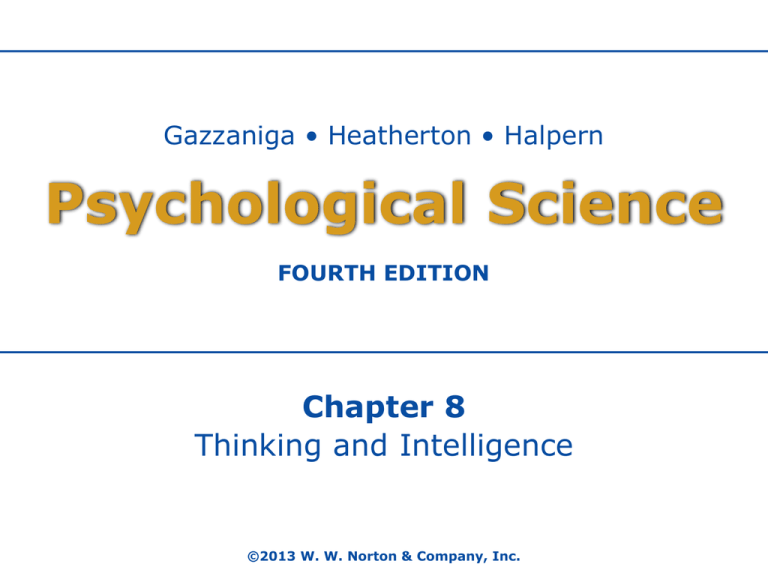
Gazzaniga • Heatherton • Halpern
Psychological Science
FOURTH EDITION
Chapter 8
Thinking and Intelligence
©2013 W. W. Norton & Company, Inc.
“Mind Reading”
As pollsters often demonstrate during elections, reading
minds, whether of voters or the person next to you, is close to
impossible. However, as this ScienCentral News video explains,
scientists are one step closer to reading our thoughts.
Thinking and Intelligence
• GerdGigerenzer has written about fears that he calls
dread risks
• Dread risks can result when events with dire
consequences receive a lot of publicity, even when
the publicized events have a low probability of
recurring
• The resulting fears can profoundly affect reasoning
and decision making
– 9/11 caused many more people to fear flying even though
the number of people who die in car accidents every year
far exceeds the number who die in airline disasters or
hijackings
8.1 What Is Thought?
• Distinguish between analogical and symbolic
representations.
• Describe the defining attribute, prototype,
and exemplar models of concepts.
• Discuss the positive and negative
consequences of using schemas and scripts.
Thinking Is the Manipulation of
Mental Representations
• The field of cognitive psychology is the study of
thought. It was originally based on two ideas:
– The brain represents information
– Thinking is the mental manipulation of these
representations
• Our thoughts consist of mental representations of
the objects and information that we encounter in our
environments
• Cognition includes thinking and the understandings
that result from thinking
Thinking Involves
Two Types of Representations
• Analogical representations: mental representations that have
some of the physical characteristics of objects, e.g. maps
• When we think of an object, we often bring to mind a visual
image, or analogical representation, of the object
– Pause and think about a lemon: What form did your “lemon” thought
take?
• Symbolic representations: abstract mental representations
that do not correspond to the physical features of objects or
ideas, e.g. words or ideas
• Neural activity occurs when we look at objects, and it can be
reactivated when we recall the objects
Mental Maps Combine Representation
• Mental maps can include both analogical and
symbolic representations
• Symbolic representations can lead to errors, because
we can represent only a limited range of knowledge
analogically and thus use memory shortcuts
unconsciously
– Which is farther east, San Diego, California, or Reno,
Nevada?
– Which is farther north, Seattle, Washington, or Montreal,
Canada?
Concepts Are
Symbolic Representations
• Grouping things based on shared properties,
categorization, reduces the amount of
knowledge we must hold in memory and is
therefore an efficient way of thinking
• Much of our knowledge of the world is based
on concepts, or categories of items organized
around common themes
– concept: a mental representation that groups or
categorizes objects, events, or relations around
common themes
Defining Attribute Model
• Defining attribute model: In this way of thinking about concepts, a
category is characterized by a list of features that determine if an
object is a member
– For example, a “bachelor” is characterized by being unmarried
and male
• The model suggests:
– membership within a category is on an all-or-none basis;
– all of a given category’s attributes are equally important in
defining that category;
– all members of a category are equal in category membership
• We often make exceptions in our categorizations, and some
attributes are more important for defining membership
• The boundaries between categories are much fuzzier than the
defining attribute model suggests
– Is every unmarried male a “bachelor”?
Prototype Model
• Prototype model: Within each category, there is a
best example—a prototype—for that category
• One positive feature of the prototype model is that it
allows for flexibility in the representation of concepts
• One drawback related to such flexibility is that a
particular prototype can be chosen for different
reasons: Life experiences, culture, or location can
influence the prototype for a category
Exemplar Model
• Exemplar model: All members of a category are
examples (exemplars); together they form the concept
and determine category membership
• It assumes that, through experience, people form a fuzzy
representation of a concept because there is no single
representation of any concept
• It accounts for the observation that some category
members are more prototypical than others: The
prototypes are simply members we have encountered
more often
How would you explain the difference between a dog and a
cat to someone who has never seen either? Most dogs
bark, but a dog is still a dog if it does not bark
Schemas Organize Useful
Information about Environments
• Schemas are cognitive structures that help us
perceive, organize, and process information
• Scripts are schemas that dictate appropriate
behavior.
• What we view as appropriate is shaped by culture
• Schemas and scripts are adaptive in that they enable
us to make quick judgments with little effort
What sequence of events does the script going to the
movies include? How would you feel if a stranger sat
next to you in the theater, or started talking?
Schemas Organize Useful
Information about Environments
• Schemas and scripts may lead us to think and act in
stereotypical ways
– stereotypes: cognitive schemas that allow for easy, fast
processing of information about people based on their
membership in certain groups
• Gender roles are the prescribed behaviors for
females and males and represent a type of schema
that operates at the unconscious level
• The schemas and scripts that children learn are likely
to affect their behavior when they are older
Psychology: Knowledge You Can Use—
How Can Dating Scripts Help Me
Navigate in My Romantic Life?
• According to Amiraian and Sobal (2009), “Dating scripts are
shared cognitive representations of likely sequences of dating
events and sets of appropriate dating behaviors based on
social norms and previous experiences that direct decisions
and behavior on dates.”
• Knowing how a date is likely to unfold removes some of the
ambiguity of an event
• Following a generally accepted script and behaving
consistently with a set of culturally accepted rules helps
manage the impressions that other people form about you
• Let your values and beliefs guide your behavior; collaborate
on a date that feels right to you
8.2 How Do We Make Decisions
and Solve Problems?
• Distinguish between deductive and inductive
reasoning.
• Distinguish between normative and
descriptive models of decision making.
• Explain how heuristics, framing, and affective
forecasting influence decision making.
• Review strategies that facilitate insight and
problem solving.
8.2 How Do We Make Decisions
and Solve Problems?
• Thinking enables us to do the following:
– reasoning: using information to determine if a
conclusion is valid or reasonable
– decision making: attempting to select the best
alternative among several options
– problem solving: finding a way around an obstacle
to reach a goal
People Use Deductive
and Inductive Reasoning
• When drawing conclusions, we engage in
deductive and inductive reasoning
• Errors, such as making biased choices in what
evidence to consider, can lead to false
conclusions in both deductive and inductive
reasoning tasks
Deductive Reasoning
• In deductive reasoning, you use logic to draw specific
conclusions under certain assumptions (premises)
– deductive reasoning: using general rules to draw
conclusions about specific instances
• In research, a deductive reasoning task is often expressed as a
syllogism, e.g. If A is true, then B is true
• We can come up with a valid but incorrect conclusion,
however, if the premises use terms inconsistently or
ambiguously
– Consider the following:
• Nothing is better than a piece of warm apple pie
• A few crumbs of bread are better than nothing
• Therefore, a few crumbs of bread are better than warm
apple pie
How might prior beliefs or schemas interfere with deductive
reasoning?
Inductive Reasoning
• Inductive reasoning involves reasoning from the
specific to the general
– inductive reasoning: using specific instances to draw
conclusions about general rules
• For example, if your Italian friend is fashionable, you
may induce that Italians in general are fashionable
How might inductive reasoning lead to erroneous
conclusions?
Inductive and Deductive
Reasoning Combined
• You always bump into your roommate at the
coffee shop
• Through inductive reasoning, you believe she
really likes coffee
• Therefore you decide through deductive
reasoning to get her a Starbucks gift card for
her birthday
Reasoning and the Scientific Method
• The use of the scientific method to discover general principles
is one example of inductive reasoning
• The scientific method dictates that scientists meet certain
standards when inducing general principles from several
specific instances
• These standards are designed to guard against biases in
inductive reasoning
• In day-to-day life, however, we may be more likely to reach
inappropriate conclusions when reasoning about general
principles from everyday circumstances
• People are strongly influenced by anecdotal reports
Decision Making
Often Involves Heuristics
• In their research on decision making, psychologists
have studied normative models and descriptive
models:
– Normative models of decision making view people as
optimal decision makers
– Descriptive models account for actual behavior
• Expected utility theory is one normative model of
how we should make decisions by considering the
possible alternatives and choosing the most
desirable one
• Research has demonstrated, however, that we are
not always rational in making decisions
Decision Making
Often Involves Heuristics
• Tversky and Kahneman identified several common heuristics
– heuristics: shortcuts (rules of thumb or informal guidelines) used to
reduce the amount of thinking that is needed to make decisions
• Heuristic thinking often occurs unconsciously and allows us to
free up some cognitive resources
• Heuristic thinking can be adaptive in that it allows us to
decide quickly rather than weighing all the evidence each
time we have to decide
• Heuristics can also result in biases, which may lead to errors
or faulty decisions
• An algorithm is a procedure that, if followed correctly, will
always yield the correct answer
Framing Effects
• How information is presented can alter how
people perceive it
– framing: the effect of presentation on how
information is perceived
Framing Effects
• To account for framing’s effects, Kahneman
and Tversky came up with prospect theory, a
major theory in decision making
• Prospect theory has two main components:
– a person’s wealth affects his or her choices
– loss aversion: Because losses feel much worse
than gains feel good, a person will try to avoid
situations that involve losses
Critical Thinking Skills:
Understanding How Heuristics
Can Affect Your Thinking
• Prototypes are readily available in memory. We tend to rely
on prototypes in making decisions
– availability heuristic: making a decision based on the answer that
most easily comes to mind
• We base decisions on the extent to which each option reflects
what we already believe about a situation
– representativeness heuristic: placing a person or object in a category
if that person or object is similar to one’s prototype for that category
• Heuristics can lead to faulty reasoning if you fail to take other
information into account, such as the base rate (how
frequently an event occurs)
• Once we know that such shortcuts can lead us to make faulty
judgments, we can use heuristics carefully as we seek to make
rational decisions
Affective Forecasting
• Gilbert and Wilson have found that people are not good at
affective forecasting, or predicting how they will feel about a
future event
• People tend to overestimate the extent to which negative
events will affect them in the future
• We engage in adaptive strategies — such as rationalizing why
an event happened and minimizing the event’s importance —
to cope with negative events.
• People seem unaware that they can find positive outcomes
from tragic events, and typically when considering a
hypothetical aversive event, they overestimate the misery and
underestimate how well they will cope with the event
• Affective forecasting can also influence our perceptions of
positive events:
– How would you feel if you won an Olympic medal?
– Now, compare winning the silver medal vs. the gold.
“Drinking vs. Talking”
You “walk the line” during a sobriety test because you shouldn’t
drive if you’ve drunk so much you can’t walk in a straight line.
But as this ScienCentral News video explains, research suggests
that talking while driving may be just as dangerous.
The Paradox of Choice
• Psychological reactance occurs when we are told what to do
and what not to do; we react by wanting to do exactly what is
forbidden to us even if we had no strong preferences before
our choices were restricted
• Iyengar and Lepper’s study indicates that having many
possibilities can make it difficult to choose one item
• According to psychologist Barry Schwartz, the consequence
of nearly unlimited choice makes some people miserable and
may help explain the increase in clinical depression. He
divides the world into satisficersand maximizers.
– Satisficerslook around until they find something that most closely
matches what they want and buy it, without worrying about whether
better or cheaper products are available
– Maximizers always seek to make the best possible choices. They
hesitate in making decisions, and they feel paralyzed by indecision
when they have to select between equally attractive choices. As a
result, they generally are more disappointed with their decisions and
more likely to experience regret
Problem Solving Achieves Goals
• A person has a problem when he or she has no
simple and direct means of attaining a particular goal
• To solve the problem, the person must use
knowledge to determine how to move from the
current state to the goal state
• Often, the person must devise strategies to
overcome obstacles
• How the person thinks about the problem can help
or hinder that person’s ability to find solutions
Organization of Subgoals
• One approach to the study of problem solving
is to identify people’s steps in solving
particular problems
• Breaking down a problem into subgoals is an
important component of problem solving
• When you are facing a complex problem,
identifying the appropriate steps or subgoals
and their order can be challenging
Sudden Insight
• Unconscious processes sometimes lead to objectively better
solutions than conscious processes do
• Insight: the sudden realization of a solution to a problem
• Köhler demonstrated that chimpanzees, as well as humans,
have insightful moments
• Maier’s study with the string and pliers provides an example
of how insight can be achieved when a problem initially
seems unsolvable
• How we view or represent a problem can significantly affect
how easily we solve it
• A saying like think outside the box embodies ideas about
insight; however, it may not be very useful without hints for
how to get started
Changing Representation
to Overcome Obstacles
• In problem solving we often need to revise a mental
representation to overcome an obstacle
– restructuring: a new way of thinking about a problem that
aids its solution; representing the problem in a novel way
• The new view reveals a solution that was not visible
under the old problem structure
Attempt to solve Sheerer’s Nine Dot Problem:
– How can you “think outside the box” to connect all nine
dots using at most four straight lines, without lifting the
pencil off the page (see next slide)?
Changing Representation
to Overcome Obstacles
• In trying to solve a problem, we commonly think
back to how we have solved similar problems
– mental sets: problem-solving strategies that have worked
in the past
• Functional fixedness (mental representations about
the typical functions of particular objects) can also
create difficulties in problem solving
• To overcome this kind of obstacle, the problem
solver needs to reinterpret the object’s potential
function, e.g. Duncker’s candle challenge
Conscious Strategies
• Two examples of conscious strategies:
– working backward: When the appropriate steps for solving
a problem are not clear, proceeding from the goal state to
the initial state can help yield a solution
– finding an appropriate analogy: Using a strategy that
works in one context can help to solve a problem that is
structurally similar with analogous constraints
• Analogous solutions work only if we recognize the
similarities between the problem we face and those
we have solved
“Writer’s Block”
Anyone who has tried to write and ended up staring at a blank
page knows the pain of writer’s block. But for some, this
barrier is devastating. As this ScienCentral News video reports,
researchers have found some nontraditional ways to unlock
extreme writer’s block.
8.3 How Do We
Understand Intelligence?
• Identify common measures of intelligence.
• Discuss the validity of measures of intelligence.
• Review theory and research related to general intelligence,
fluid intelligence, crystallized intelligence, multiple
intelligences, and emotional intelligence.
• Discuss the relationship between intelligence and cognitive
performance.
• Summarize research examining genetic and environmental
influences on intelligence.
• Discuss sex and race differences in intelligence.
• Define stereotype threat.
8.3 How Do We
Understand Intelligence?
• Individuals differ in terms of intelligence just as they
differ physically and in terms of their personalities.
– intelligence: the ability to use knowledge to reason, make
decisions, make sense of events, solve problems,
understand complex ideas, learn quickly, and adapt to
environmental challenges
• Psychologists consider two aspects when measuring
intelligence: They study the ways that knowledge
and its applications in everyday life translate into
intelligence, and they examine the degree to which
intelligence is determined by genes and by
environment.
“Brainy Brains”
The size of your brain doesn’t necessarily determine how
smart you are; your IQ, brain researchers say, is more
influenced by how your brain thickens and thins when you’re a
kid. This ScienCentral News video has more.
Intelligence Is Assessed
with Psychometric Tests
• The psychometric approach to measuring intelligence focuses
on how people perform on standardized tests
• Some psychometric tests focus on achievement;other
psychometric tests focus on aptitude
• Binet proposed that intelligence is best understood as a
collection of high-level mental processes
• Psychometric tests of general intelligence include the
Stanford-Binet test, which measures intelligence using the
intelligence quotient, or IQ score
• The Wechsler Adult Intelligence Scale has two parts: verbal
and performance
Intelligence Quotient
• Binet introduced the important concept of mental age:
– mental age: an assessment of a child’s intellectual standing compared
with that of same-age peers; determined by comparing the child’s test
score with the average score for children of each chronological age
• The intelligence quotient (IQ) was developed by the
psychologist Wilhelm Stern:
– intelligence quotient (IQ): an index of intelligence computed by
dividing a child’s estimated mental age by the child’s chronological
age, then multiplying this number by 100
• IQ in the adult range is measured in comparison with the
average adult and not with adults at different ages
• Across large groups of people, the distribution of IQ scores
forms a bell curve, or normal distribution;most people are
close to the average
Validity of Testing
• The overall evidence indicates that IQ is a fairly good predictor
of life outcomes, e.g. doing well at school
• Data suggests modest correlations between IQ and work
performance, IQ and income, IQ and jobs requiring complex
skills
• IQ scores typically predict only about 25 percent of the
variation in performance at either school or work
• IQ may be important, but it is only one of the factors that
contributes to success in the classroom, the workplace, and
life generally; additional factors include background, selfcontrol, motivation, and willingness to work
Cultural Bias
• One important criticism of intelligence tests is that they may
penalize people for belonging to particular cultures or
particular groups
• A person’s exposure to mainstream language and culture
affects which meaning of a word comes most quickly to mind,
if the person knows the meaning at all:
– What does it mean when someone says something is “rad”?
• Most measures of IQ reflect values of what is considered
important in modern Western culture
• What is adaptive in one society is not necessarily adaptive in
others
• One approach to dealing with cultural bias is to use items that
do not depend on language, e.g. performance measures on
the Wechsler Adult Intelligence Scale (WAIS)
Critical Thinking Skill:
Recognizing and Avoiding Reification
• Reification is the tendency to think about complex traits as
though they have a single cause and an objective reality, e.g.
the complex concept of intelligence
• Intelligence is a multifaceted concept defined within a
context, not just by a score in isolation
– For example, if English is your native language but you speak enough
Spanish to take an intelligence test in Spanish, you probably would not
expect the resulting IQ to reflect your intelligence accurately
• Critical thinkers avoid treating an abstract concept as though
it has a tangible reality. They recognize the complexity in
complex concepts
General Intelligence Involves
Multiple Components
• An early line of research examined the correlations
among intelligence test items using factor analysis
– In this statistical technique, items similar to one another
are clustered, and the clusters are referred to as factors
• Charles Spearman found that most intelligence test
items tended to cluster as one factor
• Spearman viewed general intelligence, or g, as a
factor that contributes to performance on any
intellectual task
– general intelligence (g): the idea that one general factor
underlies intelligence
The Importance of g
• Research has shown that g influences important life
outcomes, such as by predicting performance in school and at
work
• Low g is related to early death from causes including heart
disease, diabetes, stroke, Alzheimer’s disease, traffic
accidents, and drownings
• However, researchers from the United Kingdom and Finland
found that lower socioeconomic status may be the most
important predictor of early mortality
• A number of theorists have proposed that g’s main value is in
allowing people to adapt quickly to environmental challenges
• Although most psychologists agree that some form of g exists,
they also recognize that intelligence comes in various forms
Fluid Versus Crystallized Intelligence
• Raymond Cattell (1971) proposed that g consists of two types
of intelligence:
– fluid intelligence: intelligence that reflects the ability to process
information, particularly in novel or complex circumstances, e.g.
reasoning
– crystallized intelligence: intelligence that reflects both the knowledge
one acquires through experience and the ability to use that knowledge
• Distinguishing between fluid intelligence and crystallized
intelligence is somewhat analogous to distinguishing between
working memory (more like fluid intelligence) and long-term
memory (more like crystallized intelligence)
• Crystallized intelligence grows steadily throughout the adult
years, while fluid intelligence declines steadily
Multiple Intelligences
• Howard Gardner proposed a theory of multiple intelligences:
– multiple intelligences: the idea that there are different types of intelligence
that are independent of one another
• Proposed intelligences include: musical, bodily-kinesthetic, linguistic,
mathematical/logical, spatial, intrapersonal, and interpersonal (social
understanding) intelligence
• There are still no standardized ways to assess many of Gardner’s
intelligences and some psychologists argue these are special talents
• Sternberg theorized that there are three types of intelligence:
– Analytical intelligence is similar to that measured by psychometric tests—
being good at problem solving and other academic challenges;
– Creative intelligence involves the ability to gain insight and solve novel
problems—to think in new and interesting ways;
– Practical intelligence refers to dealing with everyday tasks, such as knowing
whether a parking space is large enough for your vehicle
• Evidence for the existence of such multiple intelligences is presented in
the cases of many phenomenally successful public figures who did not
excel academically, e.g. Bill Gates dropped out of college
Emotional Intelligence
• Emotional intelligence (EI) was conceived by the
psychologists Peter Salovey and John Mayer and popularized
by the science writer Daniel Goleman
– emotional intelligence (EI): a form of social intelligence that
emphasizes the abilities to manage, recognize, and understand
emotions and use emotions to guide appropriate thought and action
• Regulating our moods, resisting impulses and temptations,
and controlling our behaviors are all important components of
EI
• Emotional intelligence is correlated with the quality of social
relationships
• Some critics have questioned whether EI really is a type of
intelligence or whether it stretches the definition of
intelligence too far
Intelligence Is Associated
with Cognitive Performance
• Galton believed that intelligence was related
to the speed of neural responses and the
sensitivity of the sensory/perceptual systems,
and he speculated that intelligent people have
larger, more efficient brains
• Other psychologists believe intelligence is
supported by low-level cognitive processes,
such as mental processing, working memory,
and attention
Speed of Mental Processing
• People who score higher on intelligence tests respond more quickly and
consistently on reaction time tests
– A test of simple reaction time might require a person to press a computer key
as quickly as possible whenever a stimulus appears on the screen
• Further support for the relation between general intelligence and speed of
mental processing comes from inspection time tests:
– If a stimulus is presented and then covered up, how much viewing time does a
particular person need to answer a question about the stimulus?
• By measuring the electrical activity of brains in response to the
presentation of stimuli, researchers have found that highly intelligent
people’s brains work faster than less intelligent people’s brains
• The relation between general intelligence and mental speed appears to be
correlated with the greater longevity of people with high IQs
• The relationship between reaction time and longevity was somewhat
stronger than the relationship between scores on standardized
intelligence tests and longevity
Working Memory
• General intelligence scores are closely related to
working memory but are not identical
• Studies differentiate between simple tests of
memory span and memory tests that require some
form of secondary processing
• Memory tests that have dual components, however,
show a strong relation between working memory
and general intelligence
• The link between working memory and general
intelligence may be attention, or the ability to pay
attention
Brain Structure and Function
• Many studies have documented a relationship between head
circumference, which researchers use to estimate brain size, and
scores on intelligence tests
• Studies using magnetic resonance imaging have found a small but
significant correlation between the size of selected brain structures
and scores on intelligence tests
• These findings are correlations, however, so we cannot infer that brain
size necessarily causes differences in intelligence
• Different kinds of intelligence seem to be related to the sizes of certain
brain regions. These regions include areas associated with working
memory, planning, reasoning, and problem solving
• General intelligence appears to be associated mainly with increased
cortex size
• These findings are consistent with evidence that injury to the frontal
lobes causes impairments in fluid intelligence but not in crystallized
intelligence
Savants
• Savants have minimal intellectual capacities in most
domains, but at a very early age each savant shows
an exceptional ability in some “intelligent” process
• A savant’s exceptional ability may be related to math,
music, or art
• The combination of prodigious memory and the
inability to learn seemingly basic tasks is a great
mystery; this rare combination adds a dimension to
our understanding of intelligence
Genes and Environment
Influence Intelligence
• Even if intelligence has a genetic component, the way
intelligence becomes expressed is affected by various
situational circumstances
– For example, the capacity for having a large vocabulary is
considerably heritable, but every word in a person’s
vocabulary is learned in an environment
• Instead of seeking to demonstrate whether nature or
nurture is the more important factor, psychologists
try to identify how each of these crucial factors
contributes to intelligence
Behavioral Genetics
• Numerous behavioral genetics studies have made clear
that genes help determine intelligence—but the extent
to which genes do so is difficult to determine
• Behavioral geneticists study the genetic basis of
behaviors and traits such as intelligence; they use twin
and adoption studies to estimate the extent to which
particular traits are heritable
• Even when raised apart, twins who have inherited an
advantage might receive some social multiplier, an
environmental factor or an entire environment, that
increases what might have started as a small advantage
– Suppose twins have inherited a higher than average verbal
ability? Adults who notice this ability might read to them
more often and give them more books
Environmental Factors
• Prenatal and postnatal factors, such as poor nutrition, can
affect brain development and result in lower intelligence
• Research from numerous laboratories has shown that
enriched environments enhance learning and memory
• The implication is that environment influences how genes
involved in brain development are expressed
• Schooling encourages the development of children’s brains
and cognitive capacities and therefore fosters intelligence
• The dramatic rise of IQ scores during the last century has
been called the Flynn effect after James R. Flynn, the
researcher who first described it
• Since genes cannot have changed much during this period,
the increase must be due to environmental factors
“Go Play Outside”
Feel like you’re suffering from brain drain and can’t
concentrate? Psychologists have found that taking some time
to interact with nature, even in cold weather; can make you a
bit smarter.
Group Differences in Intelligence
Have Multiple Determinants
• Which is the smarter sex?
• Using IQ scores to determine which is the smarter
sex does not work because most of the commonly
used intelligence tests were written in ways that
would avoid creating an overall sex difference in IQ
• Using only tests that had not deliberately eliminated
sex differences, Jensen found no evidence for sex
differences in the mean level of g or in the variability
of g. Males, on average, excel on some factors;
females on others
Group Differences in Intelligence
Have Multiple Determinants
• Are there intelligence differences based on race?
• The most controversial aspect of intelligence testing over the
last century has been the idea that genetics can explain
overall differences in intelligence scores between racial
groups
– In a 1969 paper, Jensen created a firestorm of controversy by asserting
that African Americans are, on average, less intelligent than European
Americans
• Given the importance of intelligence to educational and
career attainment, claims that some groups are superior to
others require close scrutiny, and it is important to discuss
controversial and sensitive topics with an eye to being as fair
to all sides as possible
Group Differences in Intelligence
Have Multiple Determinants
• Whether the effects of race are real or not, it is not
scientifically appropriate to conclude that genes cause
differences between groups if there are any environmental
differences between those groups
• Research has demonstrated that stereotype threat may be
reduced by informing people of the negative consequences of
stereotype threat, having people focus on positive aspects of
their lives, and bolstering people’s peer relations and social
connections.
– stereotype threat: apprehension about confirming negative
stereotypes related to one’s own group




